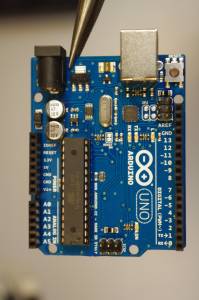workshops:arduino_for_the_curious:arduino
The Arduino is a essentially a small computer that can fit in your hand. It's much slower and more low-power than a normal computer, but it does most of the same things:
- It can run software
- It can communicate with other computers
- It can control hardware - LEDs, storage devices, sensors, etc
- It can store data internally
Here is a picture of an Arduino UNO:
There are 14 digital IO pins labelled 0-13.
- Pins 0 and 1 are special and used for communicating with the computer via USB. You shouldn't use them unless you know what you are doing!
- Pin 13 is special because it is attached to an onboard LED. Try setting this pin to a high voltage and you'll see it light up!
- Pins 3,5,6,9,10,11 are special because they support PWM, a sort of analogue output technique.
On the left there are 6 Analog input pins labelled A0-A5
- They can measure 0V to 5V in increments of around 5mV
- They can also be used as digital IO if you really need some extra pins - their numbers as digital IO are 14+analogue pin number. So A3 is pin number 14+3 = 17
workshops/arduino_for_the_curious/arduino.txt · Last modified: by 127.0.0.1
